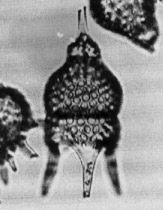 Thyrsocyrtis
(Thyrsocyrtis) tarsipes Foreman
Thyrsocyrtis
(Thyrsocyrtis) tarsipes Foreman Thyrsocyrtis
(Thyrsocyrtis) tarsipes Foreman
Thyrsocyrtis
(Thyrsocyrtis) tarsipes ForemanThyrsocyrtis tarsipes Foreman, 1973, p.442, pl.3, fig.9, pl.12, fig.14; Sanfilippo and Riedel, 1982, p.174, pl.1, figs.1-2
Subcylindrical form. Small, spherical cephalis with moderate number of small pores and cylindro-conical horn of usually 2-3 times its length. Thorax campanulate to inflated, usually as wide as, or wider than abdomen, with circular, close-packed pores. Vestigial wings commonly present halfway down the segment. Lumbar stricture usually distinct. Abdomen annular to short cylindrical, with pores generally less regular than those of thorax. Feet tapering from peristome, subcylindrical, irregularly and finely perforate, usually divergent (Sanfilippo and Riedel, 1982).
Based on 10 specimens. Length excluding horn 180-230 µm, of cephalothorax 75-95 µm, of abdomen 35-55 µm. Maximum breadth 80-105 µm (Sanfilippo and Riedel, 1982).
T. tarsipes is distinguished from its descendant, T. hirsuta, in its generally smaller size and porous feet (Sanfilippo et al., 1985).
The campanulate to inflated thorax commonly bears three vestigial wings. The cylindrical to slightly inflated abdomen is rounded-triangular in cross-section, shorter than, and of approximately the same width as the thorax. Abdominal pores are generally irregular in size and shape, as large to twice as large as those of the thorax, and more widely spaced. The three feet vary in length, and are irregularly perforated (Sanfilippo et al., 1985).
T. tarsipes occurs in Paleocene to early early Eocene sediments from the Atlantic (DSDP 384), the Caribbean and the Gulf of Mexico from 15°S to 30°N. Its morphotypic first appearance has not been determined. Its morphotypic last appearance lies within the Buryella clinata Zone.
T. tarsipes, or an ancestor common to both, apparently gave rise to T. hirsuta.